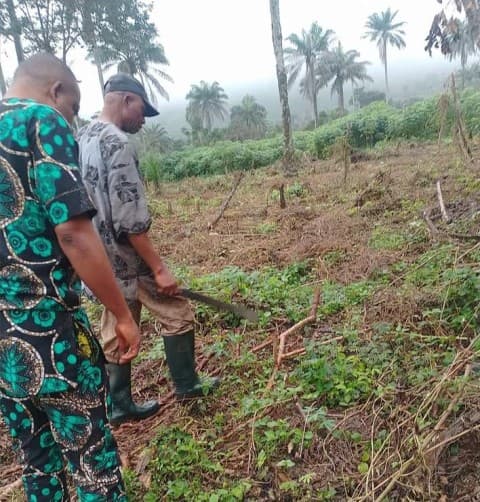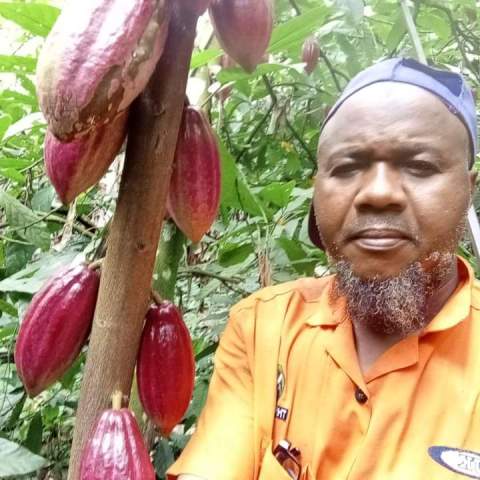There are considerable challenges, bordering on tension and near- panic among farmers in the agrarian community of Esa Oke due to the inadequate rainfall this year 2024. Poor climatic conditions and other factors are inhibiting bounteous harvests in the farms. The noise about the climate change seemed remote to them, as few ever heard of the geophysical term or of Federal Government efforts in dousing the impact.
In Esa Oke, across the four Quarters of the community, there are good numbers of commercial and sustenance farmers. There are also huge cocoa plantations, mainly by the Erinjiyan and Oke Esa people, and food crops, especially yams and cassava by the Idofin and Odo Ese people. But all their efforts are now in jeopardy if the poor rainfall should continue.
Farmers, according to www.esaoketodayonline.com correspondents are lamenting the vulnerability in the farm produces caused by the general poor rainfall, and shift in climate conditions have affected many crops, both cash and foods.
The Federal Government had to send a huge delegation to the Climate Change Conference in Dubai, United Arab Emirates earlier in 2024.
According to Wikipedia, Climate Change in Nigeria is evident from temperature increase, rainfall variability (increasing in coastal areas and decline in continental areas). It is also reflected in drought, desertification, rising sea levels, erosion, floods, thunderstorms, bush fires, landslides, land degradation, more frequent, extreme weather conditions and loss of biodiversity. All of these continue to negatively affect human and animal life and also the ecosystems in Nigeria.

Although, depending on the location, regions experience climate change with significantly higher temperatures during the dry seasons while rainfall during rainy seasons help keep the temperature at milder levels. According to www.esaoketodayonline.com findings, the Effects of Climate Change prompted the World Meteorological Organization, in its 40th Executive Council 1988, to establish a new international scientific assessment panel to be called the International Panel on Climate Change (IPCC).[3] The 2007 IPCC’s fourth and final Assessment Report (AR4) revealed that there is a considerable threat of Climate Change that requires urgent global attention. The report further attributed the present global warming to largely anthropogenic practices. The Earth is almost at a point of no return as it faces environmental threats which include atmospheric and marine pollution, global warming, ozone depletion, the dangers of pollution by nuclear and other hazardous substances, and the extinction of various wildlife species.
However, the escalation of climate variability in Nigeria has led to heightened and irregular rainfall patterns, exacerbating land degradation and resulting in more severe floods and erosion. As one of the top ten most vulnerable countries to the effects of climate change, Nigeria has experienced a worsening of these environmental challenges.
Nigeria, it can be noted, has three different climate zones: a Sahelian hot and semi-arid climate in the north, a tropical monsoon climate in the south, and a tropical savannah environment in the centre regions. While the core regions only get one rainy and one dry season, the southern parts see heavy rainfall from March to October. There is a lot of annual variance in the north, which causes droughts and flooding. The mean annual temperature of the country varies greatly between coastal and interior regions; the plateau has a mean temperature between 21°C and 27°C, while the interior lowlands typically see temperatures above 27°C. There is variation in rainfall from April to October, and the average annual temperature is 26.9°C.
Nigeria has a tropical climate with two seasons: (wet and dry). Inland areas especially those in the northeast, experience the greatest fluctuations in temperatures as before the outset of rains, temperatures sometimes rise as high as 44 °C and drops to 6 °C between December and February. In Maiduguri, the maximum temperature may rise to 38 °C in April and May while in the same season frosts might occur at night.[27]
Already, Esa Oke has started experiencing parts of the likely consequences of Climate Change. Generally, the country is likely to experience exacerbated floods, droughts, heat waves, hampering agricultural production in hotter and drier seasons.
www.esaoketodayonline.com correspondents reported that farmers in the community were facing complex and multifaceted problems. According to them, in the past, rainfall begins from about the middle of March, but nowadays, rains do not start until late May or June.
Farmers spoken to claim that this change of climate has brought a lot challenges to farming and farmers in the community.
A farmer lamented to our correspondent that early in year 2023, there were early rainfalls in April. With this, farmers rushed to plant early raining season maize, but that those rains suddenly stopped after a few days. All the crops withered off, resulting in huge losses to the farmers.
Another farmer told www.esaoketodayonline.com that climate change plays a significant role in farming and it is one of the major challenges facing farmers in Esa Oke. He believed ‘it is fair to say that drought, floods and other extreme weather conditions have impacted agricultural productivity’.
Aside the damage being done to the farm produces by inadequate rainfall and harsh weather, the farmers are also complaining of poor access to credit and financing facilities.
Some of the farmers spoken to recalled that ‘in the past, farmers organized themselves into credit and thrift and various co-operative societies. Government through the Ministry of Agriculture and Rural Development would register them and grant them loans and farm implements; all these facilities are long gone, leaving the peasant farmers to some greedy and exploitative private produce merchants.
Another problem confronting the farmers is the terribly poor infrastructure development in the town. Reports from the four Quarters of the town indicate poor access roads to access the deeper forest lineage farmlands.
From Erinjiyan, Idofin, Oke Esa and Odo Esa, the reports getting to www.esaoketodayonline.com are that there were no roads linking their farmlands to the main roads, either the one from Ilesa or the one to Oke Imesi.
And these farmlands are where the huge chunks of cash crops like cocoa, kola nuts, palm oil were, while the Idofin and Odo Ese people planted massive yams, cassava, maize, pepper, tomato, in their areas.
